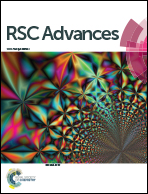A new recyclable 1,4-bis(3-methylimidazolium-1-yl)butane ditribromide [bMImB]·(Br3)2 ionic liquid reagent for selective bromination of anilines or phenols and α-bromination of alkanones under mild conditions†
Abstract
1,4-Bis(3-methylimidazolium-1-yl)butane ditribromide [bMImB]·(Br3)2 has been synthesized and explored as a new efficient brominating agent. The crystalline ditribromide reagent is stable for months and acts as a safe source of bromine requiring just 0.5 equiv. for complete bromination. It has a high active bromine content per molecule and shows a remarkable reactivity toward various substrates in acetonitrile at room temperature. The prepared reagents were used as a green recyclable reaction media for the selective bromination of anilines, phenols and α-bromination of alkanones in excellent yields. The product can easily be isolated by just washing the highly water soluble 1,4-bis(3-methylimidazolium-1-yl)butane ditribromide [bMImB]·(Br3)2 from the brominated product. The spent reagent can be recovered, regenerated, and reused without any significant loss.
![Graphical abstract: A new recyclable 1,4-bis(3-methylimidazolium-1-yl)butane ditribromide [bMImB]·(Br3)2 ionic liquid reagent for selective bromination of anilines or phenols and α-bromination of alkanones under mild conditions](/en/Image/Get?imageInfo.ImageType=GA&imageInfo.ImageIdentifier.ManuscriptID=C4RA03006K&imageInfo.ImageIdentifier.Year=2014)

 Please wait while we load your content...
Please wait while we load your content...